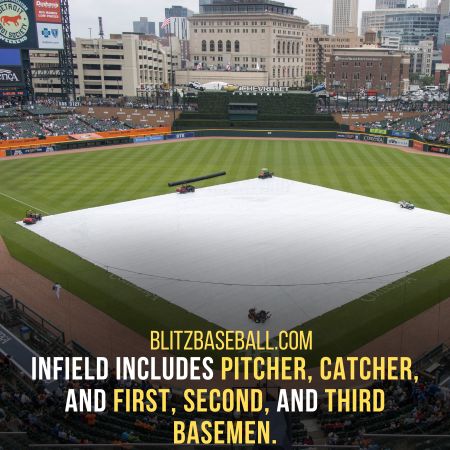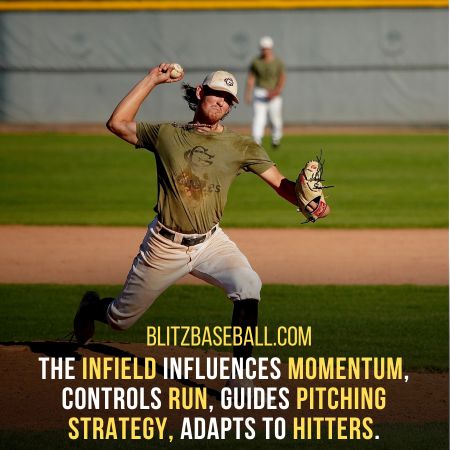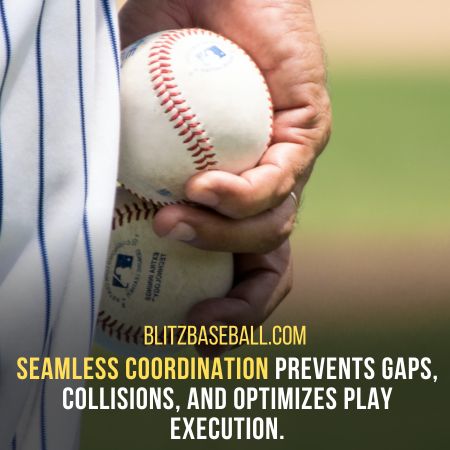Baseball, often referred to as America’s pastime, is a sport rich in tradition and strategy.
While every aspect of the game holds its own significance, the infield stands as the nucleus of defensive prowess.
This critical zone, enclosed by the bases of first, second, and third, along with the home plate, is where the action unfolds and the art of defensive baseball is masterfully executed.
In this article, we will delve into what is infield in baseball, exploring its key positions, defensive roles, and strategic importance within the game.
Key Points:
- Infield includes pitcher, catcher, and first, second, and third basemen.
- it executes double plays, shift defense, bunt defense, and cut-offs.
- Infield influences momentum, controls runs, guides pitching strategy, adapts to hitters.
- Seamless coordination prevents gaps, collisions, and optimizes play execution.
- It embodies baseball’s artistry, teamwork, and skill, shaping game outcomes and preserving tradition.
What is Infield in Baseball: The Defensive Core
The baseball infield encompasses the diamond’s inner sanctum, comprising the pitcher, catcher, and three infield positions.
These players collaborate seamlessly to thwart opponents, executing pivotal double plays, strategic shifts, and precise bunt defenses.
As the heartbeat of defensive strategy, the infield’s swift communication and flawless execution limit runs, dictate pitching tactics, and adapt to hitters.
Its enduring significance transcends routine plays, shaping game momentum and embodying baseball’s intricate artistry.
This core defensive unit epitomizes the sport’s essence, where anticipation, teamwork, and skill converge to create a symphony of strategic brilliance on the diamond.
The Infield Positions: Guardians of the Diamond
The baseball infield consists of four primary positions: the pitcher, the catcher, and the three infielders – first baseman, second baseman, and third baseman.
Each role within this defensive unit serves a distinct purpose, contributing to the team’s overall defensive strategy.
- The Pitcher: Often considered the quarterback of the defense, the pitcher holds a central role in the infield. Positioned on the pitcher’s mound, this player is responsible for initiating the play by delivering the ball to home plate. Pitchers possess an array of pitches and techniques to challenge hitters, aiming to induce ground balls and pop-ups that engage the infielders.
- The Catcher: Positioned behind home plate, the catcher is the field general, communicating with the pitcher and orchestrating defensive alignments. Along with receiving pitches and attempting to frame them for favorable calls, catchers play a crucial role in controlling the opponent’s running game by attempting to throw out base runners attempting to steal.
- The First Baseman: Positioned near first base, the first baseman’s primary role is to catch throws from fellow infielders and complete plays initiated by ground balls or bunts. Additionally, they need to cover the first base bag swiftly to retire the batter-runner. First basemen are often tall and agile, capable of stretching for errant throws to record outs.
- The Second Baseman: Positioned between first and second base, the second baseman is involved in double-play situations and assists with plays from the shortstop. They cover second base during stolen base attempts and collaborate with the shortstop to thwart ground balls up the middle.
- The Third Baseman: Positioned near third base, the third baseman must react quickly to sharply hit balls down the line and execute throws to first. They also play a vital role in guarding against bunts and sacrificing plays, charging in to field the ball and make accurate throws.

Defensive Roles and Strategies in the Infield
The baseball infield is a ballet of coordinated movements and precise execution, where every player’s role seamlessly integrates to thwart the opposing team’s advances.
Here are some key defensive roles and strategies within the infield:
- Double Plays: One of the most exhilarating plays in baseball, the double play involves turning two outs in a single play. The middle infield duo of the second baseman and shortstop must execute swift exchanges to catch the ball, step on second base, and make a strong throw to first before the batter-runner reaches the base.
- Shift Defense: In modern baseball, defensive shifts have become a common strategy to counter a hitter’s tendencies. Infielders adjust their positions based on the hitter’s tendencies, aiming to increase the chances of making outs. For instance, a shift might involve moving the second baseman into shallow right field against a left-handed pull hitter.
- Bunt Defense: When a batter attempts a bunt to surprise the defense, the infielders must communicate and react quickly. The third baseman charges in to field the bunt, while the first baseman holds their position to cover first base, and the pitcher or catcher might also assist in making the play.
- Cut-Offs and Relays: In situations involving hits to the outfield, infielders play a pivotal role in relaying the ball to home plate or other bases to prevent base runners from advancing. Cut-off plays involve an infielder positioned strategically between the outfielder and the target base to ensure efficient and accurate throws.
- Communication and Coverage: Seamless communication is vital in the infield. Infielders must call for fly balls to avoid collisions, signal their intentions to handle specific plays, and cover each other’s positions when necessary, ensuring there are no gaps in the defensive coverage.

Strategic Significance and Impact
The infield’s significance transcends mere defensive plays; it influences the broader game strategy.
The art of infield play directly impacts a team’s ability to control the pace of the game, limit the opponent’s scoring opportunities, and execute game-changing plays.
- Controlling Momentum: Successfully executed defensive plays in the infield can shift the momentum of a game. A well-timed double play or a stellar play by the third baseman to rob a batter of a hit can ignite the team’s energy and deflate the opposing side’s morale.
- Limiting Runs: The infield’s ability to turn hits into outs directly affects the opponent’s ability to score runs. A strong infield defense can prevent base hits from turning into extra-base hits and keep runners from advancing, thereby minimizing scoring opportunities.
- Strategic Pitching: Pitchers often rely on their infielders to induce ground balls and pop-ups. The infield’s positioning and ability to execute plays impact the pitcher’s pitch selection and strategy, helping keep hitters off balance and inducing weak contact.
- Adapting to Hitters: Defensive shifts and positioning in the infield are based on thorough analysis of hitters’ tendencies. Infielders adjust their positions based on data, anticipating where the batter is likely to hit the ball, thus increasing the likelihood of making outs.
Frequently Asked Questions
What positions make up the baseball infield?
The baseball infield consists of five primary positions: the pitcher, catcher, first baseman, second baseman, and third baseman. Each position has distinct defensive responsibilities and plays a crucial role in executing defensive strategies.
How do infielders contribute to defensive plays?
Infielders are involved in various defensive plays, including double plays, cut-offs and relays, bunt defenses, and strategic shifts. They collaborate to prevent base hits, turn ground balls into outs, and execute coordinated plays that help control the momentum of the game and limit the opponent’s scoring opportunities.
What is the strategic significance of the baseball infield?
The infield’s strategic importance lies in its ability to shape the game’s outcome. Infielders impact pitching strategies, adapt to hitters’ tendencies through shifts, and control the pace of the game by executing key plays. Their seamless communication, quick reflexes, and tactical awareness combine to create a dynamic defensive unit that influences the ebb and flow of baseball contests.

Conclusion
In the intricate tapestry of baseball, the infield stands as a testament to the sport’s depth and strategic complexity.
Beyond its physical boundaries, the infield is a realm of anticipation, coordination, and execution.
The players who patrol this sacred territory are the unsung heroes of defensive excellence, their efforts shaping the outcome of games and defining the essence of baseball strategy.
As the game continues to evolve, the timeless art of infield play remains a cornerstone of baseball’s enduring legacy.
